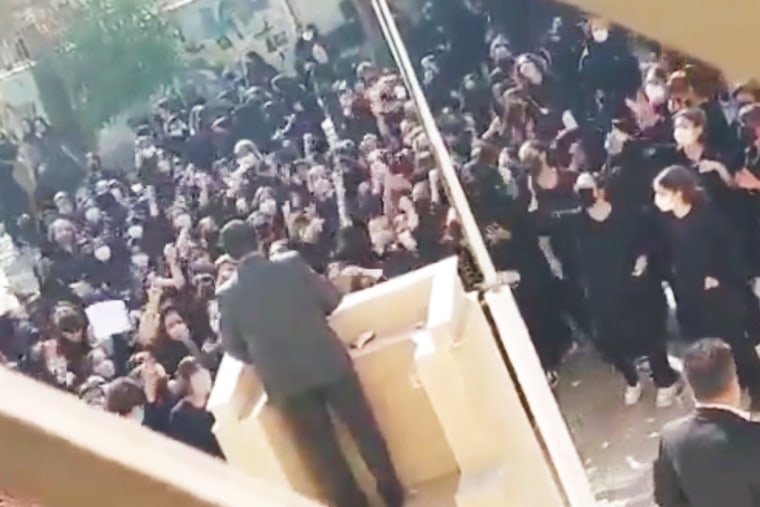What is the latest challenge for Iran’s cleric-led government as it works to crush weeks of anti-government protests? Schoolgirls.
As demonstrations convulse the country in the wake of the death in morality police custody of Mahsa Amini, videos on social media reviewed by NBC News show girls in schoolyards and classrooms in Iran standing up to traditional symbols of authority.
In one from Tuesday, students can be seen waving their headscarves and punching their fists in the air, while heckling a man at a podium in front of them. The students, in a school in the southwestern city of Shiraz, are heard chanting “Basiji, go and get lost!”
NBC News cannot verify if the man shown in the video is a member of the Basij, a paramilitary organization that has been helping to violently crackdown on protests that engulfed Iran after the death of Amini, 22, in Tehran on Sept. 16.

Another evocative video, also from Tuesday and shared on Twitter by the New York-based Center for Human Rights, shows a small group of schoolgirls with their headscarves removed, standing in front of a blackboard and singing the protest song “For” written and performed by the Iranian artist, Shervin Hajipour. The song went viral on social media and has become the unofficial anthem of the women-led demonstrations.
NBC News has not been able to independently verify this video.
But the recording of the song was removed from Hajipour’s Instagram account after reports of his arrest by Iranian police last month.
And a video from the city of Karaj, just north of the Iranian capital Tehran, shows a group of schoolgirls that have removed their headscarves and are seen confronting an official from the education ministry.
The female students in the video can be seen forcing the official to leave the schoolyard, heckling him and throwing plastic bottles in his direction.
NBC News has no been able to determine what led to this incident or when it was filmed.
“It’s an indication that this is a struggle for the future,” said Hadi Ghaemi, executive director of the Center for Human Rights in Iran. “This is young people realizing that it’s a battle for their future, and that they have to be a prominent part of it. Their parents have failed to bring about change and they want to have a better life. I think that’s what’s motivating young people to be so vocal.”
Ghaemi, who grew up in Iran, added that the protests carried echoes of the 1979 revolution that toppled the Shah’s regime, when students ripped out the photos of the monarch and his family from their textbooks and burned them.
The Iranian authorities are faced with a dilemma, he said.
“It’s a conundrum. It’s very difficult for them to go after 13 to 18-year-olds with lethal force, especially when a majority of them are girls.”
However, there are at least five cases of Iranians under the age of 18 dying in the protests, according to research compiled by Ghaemi’s rights organization. Last month the human rights group Amnesty International also said it had documented children among the people killed by the government in its crackdown.
On Wednesday Human Rights Watch said that Iran’s security forces have used excessive force against women protesting peacefully across the country. Human Rights Watch said assault rifles and shotguns have been employed against the demonstrators – even against people fleeing from the police and the military.
NBC News has not been able to verify these claims.
The government has blamed what it calls “foreign enemies” for stoking the unrest.
On Monday, Iran’s supreme leader Ayatollah Ali Khamenei broke his silence on the issue and accused the United States and Israel of planning the protests when he also appeared to back the government’s crackdown.
“The duty of our security forces, including police, is to ensure the safety of the Iranian nation,” he told a group of armed forces cadets in Tehran, according to Reuters.
“Those who ignited unrest to sabotage the Islamic Republic deserve harsh prosecution and punishment,” he added.
On Friday a coroner’s report said that Amini died from multiple organ failure, and ruled out blows to the head and body as a cause of her death.
Police had said Amini died after falling ill and slipping into a coma, but her family have said that witnesses told them she had been beaten by officers.
The police have denied allegations that she was beaten.
The coroner’s report also said that due to an underlying health condition, Amini suffered a heart attack and was unable to be revived. Her family denies that she had a pre-existing condition.




